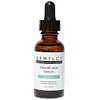What's inside
What's inside
 Key Ingredients
Key Ingredients

 Benefits
Benefits

 Concerns
Concerns

No concerns
 Ingredients Side-by-side
Ingredients Side-by-side

Estriol 0.3%
Ascorbic Acid 1%
AntioxidantHyaluronic Acid 0.5%
HumectantAloe Barbadensis Leaf
MaskingGlycerin
HumectantSodium Bisulfate
BufferingBHT
AntioxidantAcrylates/C12-22 Alkyl Methacrylate Copolymer
Aluminum Starch Octenylsuccinate
AbsorbentBis-Vinyldimethicone/Bis-Isobutyl PPG-20 Crosspolymer
EmollientCaprylic/Capric Triglyceride
MaskingCarthamus Tinctorius Seed Oil
MaskingCeteth-20
CleansingCetyl Alcohol
EmollientCyclohexasiloxane
EmollientCyclopentasiloxane
EmollientDicaprylyl Ether
EmollientDimethicone
EmollientDimethyl Isosorbide
SolventDisteardimonium Hectorite
StabilisingGlyceryl Stearate
EmollientIsodecyl Neopentanoate
EmollientIsododecane
EmollientIsopropyl Palmitate
EmollientLaureth-12
EmulsifyingLecithin
EmollientOzokerite
Emulsion StabilisingPEG-75 Stearate
Petrolatum
EmollientPolysilicone-11
Potassium Sorbate
PreservativePropylene Carbonate
SolventSilica
AbrasiveSilica Silylate
EmollientSodium Lauryl Sulfoacetate
CleansingSorbic Acid
PreservativeSteareth-20
CleansingTitanium Dioxide
Cosmetic ColorantTriethoxycaprylylsilane
Estriol 0.3%, Ascorbic Acid 1%, Hyaluronic Acid 0.5%, Aloe Barbadensis Leaf, Glycerin, Sodium Bisulfate, BHT, Acrylates/C12-22 Alkyl Methacrylate Copolymer, Aluminum Starch Octenylsuccinate, Bis-Vinyldimethicone/Bis-Isobutyl PPG-20 Crosspolymer, Caprylic/Capric Triglyceride, Carthamus Tinctorius Seed Oil, Ceteth-20, Cetyl Alcohol, Cyclohexasiloxane, Cyclopentasiloxane, Dicaprylyl Ether, Dimethicone, Dimethyl Isosorbide, Disteardimonium Hectorite, Glyceryl Stearate, Isodecyl Neopentanoate, Isododecane, Isopropyl Palmitate, Laureth-12, Lecithin, Ozokerite, PEG-75 Stearate, Petrolatum, Polysilicone-11, Potassium Sorbate, Propylene Carbonate, Silica, Silica Silylate, Sodium Lauryl Sulfoacetate, Sorbic Acid, Steareth-20, Titanium Dioxide, Triethoxycaprylylsilane
Water
Skin ConditioningGlycerin
HumectantNiacinamide
SmoothingSodium Chondroitin Sulfate
Skin ConditioningMethylglucoside Phosphate
Skin ConditioningCopper Lysinate/Prolinate
Skin ConditioningGlycosaminoglycans
EmollientBambusa Vulgaris Leaf/Stem Extract
HumectantPisum Sativum Extract
Skin ConditioningGlucosamine Hcl
Sodium Hyaluronate
HumectantPanthenol
Skin ConditioningPhenoxyethanol
PreservativeEthylhexylglycerin
Skin ConditioningPolysorbate 20
EmulsifyingDisodium EDTA
Water, Glycerin, Niacinamide, Sodium Chondroitin Sulfate, Methylglucoside Phosphate, Copper Lysinate/Prolinate, Glycosaminoglycans, Bambusa Vulgaris Leaf/Stem Extract, Pisum Sativum Extract, Glucosamine Hcl, Sodium Hyaluronate, Panthenol, Phenoxyethanol, Ethylhexylglycerin, Polysorbate 20, Disodium EDTA
 Reviews
Reviews

Alternatives
Ingredients Explained
These ingredients are found in both products.
Ingredients higher up in an ingredient list are typically present in a larger amount.
Glycerin is already naturally found in your skin. It helps moisturize and protect your skin.
A study from 2016 found glycerin to be more effective as a humectant than AHAs and hyaluronic acid.
As a humectant, it helps the skin stay hydrated by pulling moisture to your skin. The low molecular weight of glycerin allows it to pull moisture into the deeper layers of your skin.
Hydrated skin improves your skin barrier; Your skin barrier helps protect against irritants and bacteria.
Glycerin has also been found to have antimicrobial and antiviral properties. Due to these properties, glycerin is often used in wound and burn treatments.
In cosmetics, glycerin is usually derived from plants such as soybean or palm. However, it can also be sourced from animals, such as tallow or animal fat.
This ingredient is organic, colorless, odorless, and non-toxic.
Glycerin is the name for this ingredient in American English. British English uses Glycerol/Glycerine.
Learn more about Glycerin